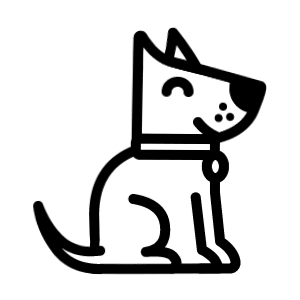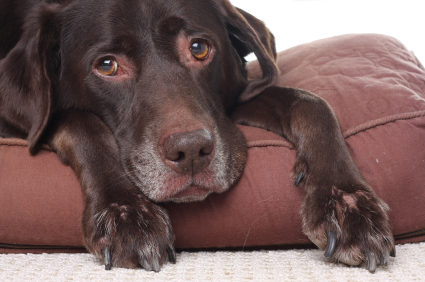Arthritis (OA/DJD)
What is arthritis?
Although several types of arthritis exist, in the majority of cases and especially in older dogs and cats, the term ‘arthritis’ is commonly used to describe osteoarthritis or degenerative joint disease. Other forms of arthritis, such as immune-mediated or septic arthritis, are diagnosed much less frequently and will not be discussed here.
Healthy joints move smoothly and without friction, due in part to a smooth cartilage layer covering the ends of the bones that make up a joint and, additionally, due to lubrication by joint fluid.
Osteoarthritis results from destruction of the cartilage layer, together with a change in the amount or consistency of the lubricating fluid. Since cartilage has no nerve endings, the early stages of disease are relatively free of clinical signs and the condition is only noticeable once the bone surface becomes involved, resulting in joint inflammation and pain. The condition usually continues to deteriorate over time, as the original cartilage layer cannot be replaced.
Until a few years ago it was thought that osteoarthritis was common in dogs, but rare in cats. We know now that cats frequently suffer from degenerative joint disease too.
WHY DO PETS GET OSTEOARTHRITIS?
Arthritis is common in older dogs and cats, simply due to wear and tear of the joints – similar to the situation in humans. In these cases no other cause can be detected.
In some instances, especially in younger dogs or cats, an underlying cause may be found – examples include hip dysplasia, patella luxation (loose kneecaps), a fracture or ruptured ligaments due to trauma. In such cases, further degeneration can sometimes be prevented by surgical repair of the joint.
WHAT ARE THE CLINICAL SIGNS OF OSTEOARTHRITIS?
Typical signs of osteoarthritis in dogs are lameness, stiffness and difficulty rising from a resting position, especially after resting for a while. Often the stiffness or lameness improves after the animal has walked for a short period, but then gets worse again with strenuous exercise. Dogs will also stop playing and lag behind on walks or sometimes refuse to walk altogether. In severe cases, affected animals can yelp with pain when moving certain joints or can become withdrawn or even aggressive.
Cats with osteoarthritis are rarely lame, so it is usually much more difficult to diagnose the disease. Owners often observe a personality change – affected individuals can become seemingly lethargic or withdrawn and sometimes aggressive when touched or cuddled. Many cats show a reduced appetite and stop grooming, resulting in a matted or unkempt coat.
Frequently, clinical signs in both dogs and cats wax and wane, which makes it more difficult for owners to spot, as their pet seems healthy one day and subdued the next. Often the condition worsens in cold, damp weather conditions.
The clinical picture of arthritis can change almost from day to day and clinical signs are often non-specific. As a result, unless a clear lameness can be observed the signs are often put down to ‘just old age’. This means that a significant proportion of older dogs and cats may be in a constant degree of pain which could be avoided with appropriate management. If you are in doubt about whether your pet suffers from osteoarthritis, it is worth making an appointment with the vet to discuss the issue.
HOW IS THE DISEASE DIAGNOSED?
In older dogs and cats the clinical signs, together with an examination of the animal (especially the joints), will usually make the diagnosis of osteoarthritis relatively straightforward. In most cases, several joints are involved in the process. Radiography (X-ray) is necessary to confirm the diagnosis. As each case is individual, we discuss the best approach with each owner who brings his or her pet to the surgery.
In cases where we suspect an underlying reason for the condition, such as hip dysplasia or ligament rupture, radiography and possibly further diagnostic tests are necessary to see whether there is an option to improve the situation by surgery.
HOW IS OSTEOARTHRITIS TREATED?
As osteoarthritis comes in different stages and different joints are affected in every pet, the approach to treatment has to be tailored to each patient’s needs, and we will discuss the options available with the owner at the outset.
Weight management is one very important issue to discuss. As arthritis is often due to wear and tear, it is not surprising that it is more common in overweight animals. Also, because pets with arthritis tend to move around less than they used to, they need fewer calories and tend to put on weight more easily. As it is not an option to increase exercise in such patients, it is very important that the amount of food given is controlled and, if necessary, reduced. Even the best drugs and other management options for arthritis may not be very successful while the patient is carrying too much weight, so this point cannot be over-emphasised.
Moderated exercise is also important – arthritic joints will actually benefit from gentle exercise. Short gentle walks two to three times a day are much better for the patient than one longer walk that results in lameness or stiffness afterwards. Non-weight-bearing exercise such as swimming is also a good way to move joints without strain and to build up or retain muscle bulk.
Hydrotherapy pools are now easy to find and can be a good way to assist in managing the condition. In certain cases physiotherapy can also be beneficial. A well padded soft bed will often help to keep an older animal comfortable when resting. Larger dogs may find it easier to get in and out of their bed if it is raised off the floor.
Despite the benefits of these management techniques it is usually necessary to give medication to help with joint function and to reduce pain. As arthritis cannot be cured, life-long medication is frequently necessary to manage the clinical signs. It is important to remember not to use human pain-killers, as some human medications can cause severe and sometimes fatal side effects in dogs and cats.
In cases of mild arthritis, many owners have found that their pets improve by adding non-prescription supplements to their food. Many different products are available, but the combination of glucosamines and chondroitin seems to work best. These are substances that provide nutrients required for repair and maintenance of joints. It is important to know that the quality of such products can differ widely and, as it can be expected that you get what you pay for, a cheaper product is usually less effective than a less inexpensive one. Good quality joint supplements can be obtained from veterinary practices.
A course of four injections of pentosan polysulphate (Cartrophen) given 5 to 7 days apart can also help to settle mild arthritis, sometimes for many months. This injection can improve the function of the cartilage and has a mild anti-inflammatory effect.
In more severe cases of arthritis, so-called non-steroidal anti-inflammatory pain killing drugs are often given – these are the equivalent to (but not the same as!!) aspirin or ibuprofen in humans. They reduce swelling and inflammation which consequently reduces pain and makes movement of the joints easier. Several different preparations are available and, depending on the individual dog, short courses or long-term medication may be more appropriate. It is important that the kidneys are working properly when this type of pain killer is given, so occasional blood tests may have to be done to check the state of the kidneys, especially when a patient needs long term medication. This type of drug should always be given together with food.
It is very important not to give human painkillers to dogs, as these can be harmful and, in some instances, even fatal.
In very severe cases of arthritis, the use of additional stronger pain killers may prove necessary. The use of such drugs has to be discussed on an individual basis.
Cases of arthritis that are not responding satisfactorily to conservative management may benefit from surgery. Intractably painful joints can either be fused (most often performed in the shoulder, carpus (wrist) or hock) or replaced (most often the hip or knee). Total hip replacement is now a commonly performed procedure on dogs of all sizes with a high success rate.
MY PET HAS OSTEOARTHRITIS, WHAT IS THE OUTLOOK?
Osteoarthritis can be a painful and debilitating disease, but in most cases we are able to allow affected animals to enjoy a good quality of life. Over time, the condition will usually deteriorate, so it is often necessary to amend the management or treatment accordingly to maintain good quality of life. Because signs of deterioration are initially subtle and because the animal will probably be on some form of medication, we will need to see your pet at intervals to assess whether the management or treatment is still appropriate or if it needs to be changed.
If you have any queries or concerns relating to your pet and arthritis please do not hesitate to contact us.




